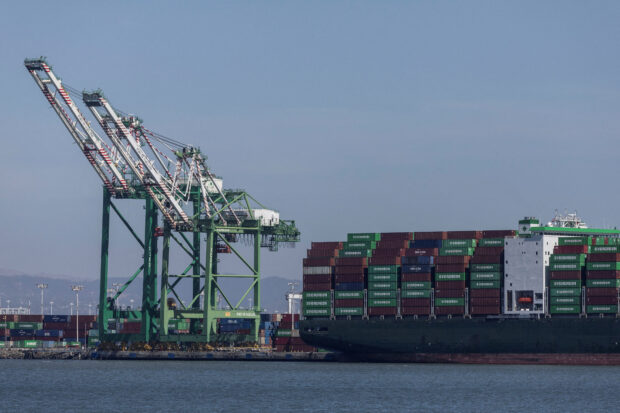
A cargo ship is seen near the port of Oakland in California, U.S., July 22, 2022. REUTERS/Carlos Barria/File photo
WASHINGTON —The U.S. trade deficit widened slightly in December, but contracted by the most in 14 years in 2023 as imports declined and exports jumped to a record high.
The report from the Commerce Department on Wednesday also showed the United States’ rising status as a major oil producer, with the inflation-adjusted value of petroleum exports surging 15.9 percent to a record high in December. The nation is now a net oil exporter and has reduced its dependence of foreign oil, helping to shrink the current account deficit.
Economists expected trade, which contributed to gross domestic product growth last year, to remain mostly supportive to the economy in 2024, though Red Sea shipping disruptions and drought in the Panama Canal posed risks.
READ: US fourth quarter economic growth handily beats expectations
“We look for net trade to remain a positive contributor to first-quarter growth,” said Matthew Martin, a U.S. economist at Oxford Economics. “The largest risk resulting from disruptions to global shipping is likely higher prices for goods, but longer lead times to receive goods could lead to either over- or underbuilding of inventories, which presents risks to our near-term outlook for imports.”
The trade deficit increased 0.5 percent to $62.2 billion, the Commerce Department’s Bureau of Economic Analysis said. Data for November was revised higher to show the trade gap shrinking to $61.9 billion instead of $63.2 billion as previously reported.
In line with forecasts
December‘s trade shortfall was in line with economists’ forecasts. While it was close to the assumptions made by the government in its advance fourth-quarter GDP estimate published last month, November’s data was revised higher. Economists said the inflation adjusted or so-called real trade deficit was now smaller than the government had assumed.
They expected that trade‘s contribution to GDP would be raised from the 0.43 percentage point estimated last month. On the bases of the December trade report, they anticipated that overall fourth-quarter GDP growth would be boosted to about a 3.6-percent annualized rate from the 3.3 percent pace reported in January when the government publishes its second estimate later this month.
“On the whole, the trade data for the fourth-quarter now look stronger than was anticipated with respect to GDP that quarter,” said Daniel Silver, an economist at JPMorgan in New York.
READ: US trade deficit shrank in November on falling imports
The trade gap narrowed 18.7 percent in 2023, the largest drop since 2009, to $773.4 billion. It represented 2.8 percent of GDP, down from 3.7 percent in 2022. Trade added more than half a percentage point to the economy’s 2.5-percent growth last year.
Exports increased 1.2 percent to a record $3 trillion last year, propelled by capital goods, automotive vehicles, parts and engines as well as consumer and other goods. Imports slumped 3.6 percent to $3.8 trillion amid decreases in industrial supplies, which include petroleum, and consumer goods.
Record high exports
Exports ended the year on a strong note, rising 1.5 percent to $258.2 billion in December. Goods exports shot up 1.8 percent to $171.2 billion. Industrial supplies and materials exports increased $3.3 billion, amid rises in nonmonetary gold, other petroleum products and crude oil.
Consumer goods exports advanced as did those of foods, feeds and beverages. Services exports climbed $0.8 billion to a record $87.0 billion, lifted by travel, transport and financial services.
Imports picked up by 1.3 percent to $320.4 billion in December. Goods imports rose 1.5 percent to $260.3 billion. There were gains in imports of consumer goods, mostly pharmaceutical preparations, and cell phones and other household goods.
Industrial supplies and materials imports also rose, but capital goods fell as did imports of automotive vehicles, parts and engines. Imports of services increased $0.5 billion to $60.1 billion amid a rise in transport. Travel services declined. The services surplus in December was the highest on record.
Decline in capital goods imports
Economists were not too concerned about the decline in capital goods imports, which on face value would suggest weaker business investment and is over time associated with recession.
READ: Between China and the US, trade takes a different route
“Recessions are normally marked by sharp contractions in import volumes and, as yet, there is no sign that this is unfolding,” said Conrad DeQuadros, senior economic advisor at Brean Capital in New York.
The real goods trade deficit declined 1.4 percent to $82.8 billion in December. Real dollar exports of petroleum rose to a record $17.3 billion from $15.0 billion in November.
Real dollar exports of foods, feeds and beverages were the highest since June 2022, while those of automotive vehicles, parts and engines hit a 1-1/2-year low.
“The outlook for trade flows going forward is likely one of moderation given expectations of slower demand and growth going forward, both domestically and abroad,” said Rubeela Farooqi, chief U.S. economist at High Frequency Economics in White Plains, New York.